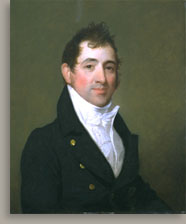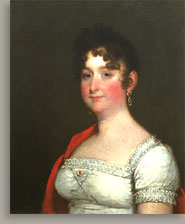 Gilbert Stuart Gilbert Stuart Margaret Crease Stackpole Welch (Mrs. Francis Welch), about 1815 Description Welch wears a high-waisted white dress with short, puffy sleeves. The square neckline is trimmed with lace, and the bodice is gathered tight with a bow at the center. Loose and broadly painted strokes of thicker white paint are visible on the sleeve, bodice, and ribbons of the bow. The contour lines of the ribbon were further defined with sketchy strokes of thin black paint. The lace was painted in a cursory manner. A few dots of white paint barely suggest a floral pattern on the lower right side of the neckline; the lower left is painted even more loosely. A bright red shawl, draped over her proper right shoulder, completely conceals her proper right arm. Stuart highlighted the cuff of her sleeve with thin strokes of red at both corners, and he added another thin red stroke to separate the cuff from her arm. Loose and jagged strokes of opaque red and black were used to define the folds in the shawl. Shadows to the left of her proper left arm and on the inside of the shawl suggest a light source to the upper right. The panel’s scored twill pattern is visible on the olive background and runs on a diagonal. Biography Margaret Crease Stackpole was active in the Old South Church, where her membership was recorded in 1809.5 A letter written in the fall of 1820 from the new minister, Rev. Benjamin B. Wisner, to Margaret C. Welch and Elizabeth Dorr thanks them for the gift of a gown given on behalf of the ladies of the congregation.6 Margaret died in Boston on May 2, 1830. Her obituary appeared in the Columbian Centinel the following week: "On Sunday morning last, Mrs. Margaret C. Welch, wife of Francis W., Esq. aged 46."7 Analysis The Welch portraits were also framed identically. According to family tradition, the frames were carved by John Doggett (1780–1857), a Boston carver, gilder, cabinetmaker, and framemaker, as well as a picture dealer.8 Margaret Welch’s sister, brother-in-law, and brother also sat for Stuart in Boston. It appears that Margaret’s older brother William Stackpole (1779–1822) might have been the first sibling to do so. He is likely the family member whose name appears on a surviving fragment of Stuart’s notebook from April 1808. On this page Stuart listed his activities and the names of sitters who had appointments. An X following a name likely indicates that the appointment was kept. For Wednesday, April 27, 1808, he recorded "Stackpole and Gay X."9 William Stackpole (about 1808, location unknown) is also on panel, but its dimensions are a bit larger than those of the Welches. Although William Stackpole married in 1803, there is no companion portrait of his wife.10 After Margaret’s sister Nancy (1777–1857) married her second husband, John Holker (d. 1820), in January 1815, they both sat for Stuart for companion portraits, and similarities between their portraits and the Welches’ in terms of composition and costume suggest that the Welches sat at the same time.11 The bust-length portraits of John Holker (about 1815, private collection) and Nancy Davis Stackpole Holker (Mrs. John Holker) (fig. 2) are close in size to the Welch portraits and are also on panel. Although their dresses are not identical, both Stackpole sisters wear high-waisted white dresses with low square necklines trimmed with lace. Their hairstyles are similar, and both have a red shawl partially draped over their arms and shoulders.12 The combination of a white dress and a red shawl is also seen in the Stuart portrait Eliza Constantia Watson Cushing (Mrs. Thomas Cushing) (1814, private collection). Though Eliza Cushing’s dress has long sleeves, it has the same square, lace-trimmed neckline, high waist, and satin bow as Margaret Welch’s. The Cushing portrait is also on panel and of similar dimensions. Its bust-length format, plain background, and pose are in keeping with Margaret Crease Stackpole Welch (Mrs. Francis Welch). Notes 2. Stackpole 1920, 128. 3. Welch [1902], 25. 4. Stackpole 1920, 128–31, and Welch [1902], 29. 5. Old South 1883, 189. 6. Hill 1890, II, 449. 7. Columbian Centinel (Boston), May 8, 1830. 8. Holmes Hinkley Welch to Louisa Dresser, March 6, 1973, Worcester Art Museum curatorial files. For John Doggett see Doggett 1894, 437, 439, and Swan 1929. See also John Doggett Records, Joseph Downs Collection, Winterthur Library, Winterthur, Del., and John Doggett Day Book 1810–1811, with other accounts to 1822, on loan to the Willard House and Museum, North Grafton, Mass. 9. Swan 1938, 308. Margaret and Nancy Stackpole were both married at that date and would have been listed by their married names: Welch and Stillman. Nancy’s first husband was John Morgan Stillman. 10. For the portrait of William Stackpole see Park 1926, II, 708, cat. no. 785. According to Park, the dimensions of this portrait are 28 3/8 x 23 1/4 inches. 11. The announcement of Nancy’s second marriage to John Holker appears in the Columbian Centinel (Boston), February 1, 1815. 12. A Welch descendant wrote, "The frames are incidentally, attributed to John Doggett of Roxbury and contemporary with the portraits. You might be interested in knowing that these two portraits belong to a set of four, identically framed. The other two are of Mr. and Mrs. John Holker. He was the first French Consul in the United States and, like Francis Welch, married a daughter of William Stackpole." See Holmes H. Welch to Louisa Dresser, March 6, 1973, Worcester Art Museum curatorial files. However, a recent comparison of the frames on the Welch portraits with the frames on Stuart’s John Holker and Nancy Davis Stackpole Holker (Mrs. John Holker) indicated that the portraits had not been framed identically. The frames on the latter pair are larger and more detailed and include alternating laurel wreaths and acanthus ornaments. For the Holker portraits see Fordney 1995, and Park 1926, I, cat. nos. 402–3, 404–5. |

